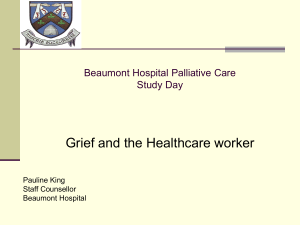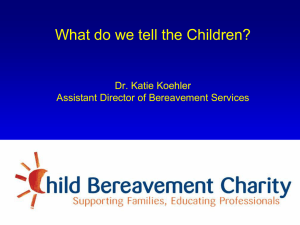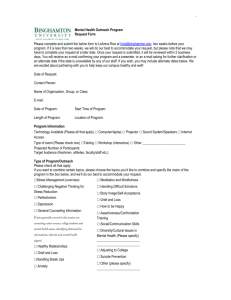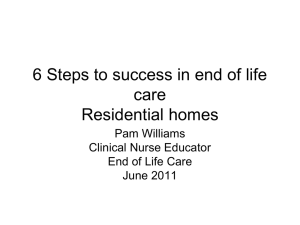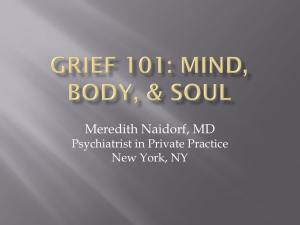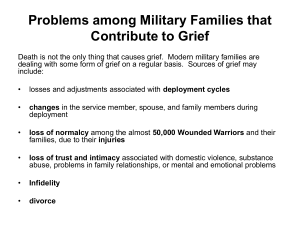Grief
advertisement
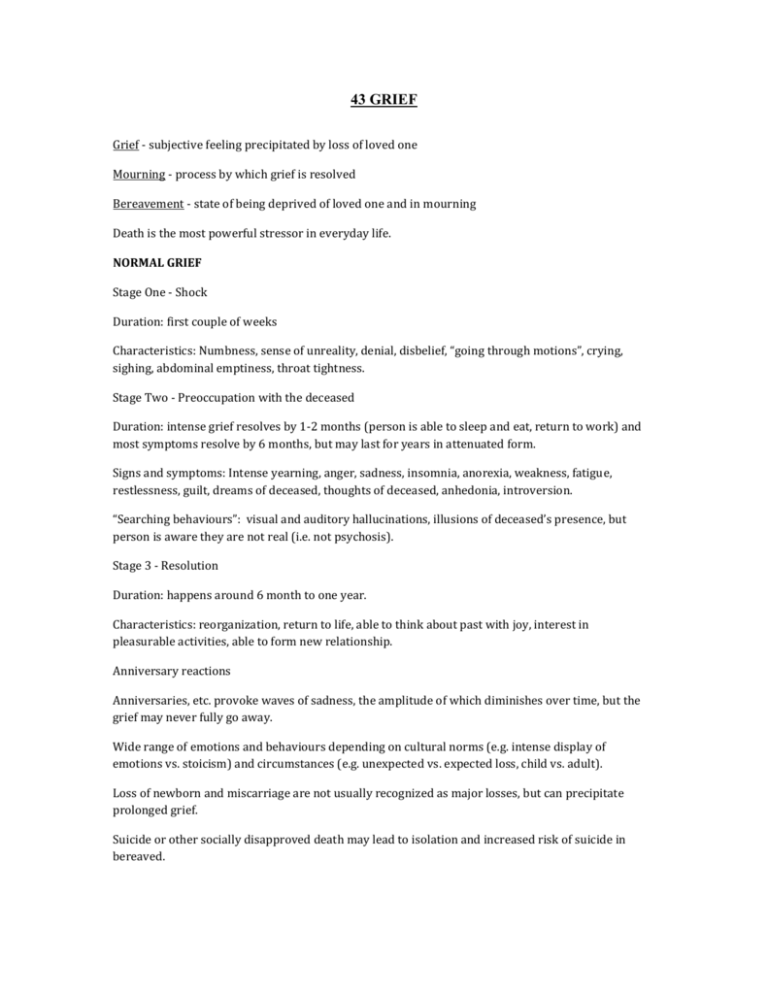
43 GRIEF Grief - subjective feeling precipitated by loss of loved one Mourning - process by which grief is resolved Bereavement - state of being deprived of loved one and in mourning Death is the most powerful stressor in everyday life. NORMAL GRIEF Stage One - Shock Duration: first couple of weeks Characteristics: Numbness, sense of unreality, denial, disbelief, “going through motions”, crying, sighing, abdominal emptiness, throat tightness. Stage Two - Preoccupation with the deceased Duration: intense grief resolves by 1-2 months (person is able to sleep and eat, return to work) and most symptoms resolve by 6 months, but may last for years in attenuated form. Signs and symptoms: Intense yearning, anger, sadness, insomnia, anorexia, weakness, fatigue, restlessness, guilt, dreams of deceased, thoughts of deceased, anhedonia, introversion. “Searching behaviours”: visual and auditory hallucinations, illusions of deceased’s presence, but person is aware they are not real (i.e. not psychosis). Stage 3 - Resolution Duration: happens around 6 month to one year. Characteristics: reorganization, return to life, able to think about past with joy, interest in pleasurable activities, able to form new relationship. Anniversary reactions Anniversaries, etc. provoke waves of sadness, the amplitude of which diminishes over time, but the grief may never fully go away. Wide range of emotions and behaviours depending on cultural norms (e.g. intense display of emotions vs. stoicism) and circumstances (e.g. unexpected vs. expected loss, child vs. adult). Loss of newborn and miscarriage are not usually recognized as major losses, but can precipitate prolonged grief. Suicide or other socially disapproved death may lead to isolation and increased risk of suicide in bereaved. ANTICIPATORY GRIEF Grieving begins when person is aware of impending death and ends with the occurrence of loss. May take form of anxiety, sadness, reconciliation attempts, and caretaking behaviour. If loss is delayed anticipatory grief may be expended and the bereaved may show few signs of acute grief. Once anticipatory grief had been expanded it may be difficult to reestablish previous relationship (e.g. persons returning from war, concentration camps). GRIEVING CHILD Resembles separation process: protest, despair, and detachment. Protest - desire for caregiver, crying. Despair - child loses hope about caregiver’s return, intermittent crying, withdrawal, apathy. Detachment - child relinquishes some emotional attachment and exhibits interest in surroundings. Child needs to find a substitute for the lost parent and they may transfer attachment to several adults. If there is no consistent person available, severe psychological damage may occur, so that the child no longer looks for, or expects, intimacy in any relationship. There is evidence that depression and suicide attempts are more common in adults who experience the death of a parent as a child. It is probably best for children to attend the funeral to prevent the ritual becoming a frightening mystery, unless the child is reluctant or refuses. DEATH OF A CHILD Parental reaction to death of child or birth of very sick infant goes through the five stages of terminal illness: shock, denial, anger, bargaining, depression and acceptance. Often a more intense experience than death of an adult, with overwhelming feeling of guilt, blame of one parent (e.g. in hereditary illnesses) helplessness, failing to protect the child. The grief may last a lifetime. Unexpected death is often more traumatic as parents do not have anticipatory grief nor a chance to overprotect the child or shower them with gifts etc.. Up to 50% of marriages in which a child dies or is born with a major malformation end in divorce. ABNORMAL BEREAVEMENT Risk factors Poor social supports, past psych. history, history of childhood separation anxiety or abuse/neglect, high initial distress, unanticipated death, other major concurrent stresses and losses, aversiveness to lifestyle change, highly dependent relationship with deceased, death of a child). Complicated grief Defined as persistence, for at least 6 months, of disruptive emotional reactions including yearning and four of: - Difficulty moving on, numbness/detachment, bitterness, feeling life is empty without deceased, trouble accepting death, future holds no meaning without deceased, being on edge or agitated, difficulty trusting others. May also exhibit social withdrawal and difficulty reengaging. Complicate grief at 6 months is highly predictive of impairment at 12 and 24 months post loss and may be at increased risk of cancer, HTN, heart disease, substance abuse, disability etc.. Sequelae of abnormal bereavement Psychological: depression in 15-35% (4-9x higher than general population), suicide (especially in older men in the first year) Physical: higher rates of mortality (esp. older men), morbidity, consumption of EtOH, tobacco, utilization of health care system, worsening of chronic medical conditions (esp. CHF, HTN). GRIEF VERSUS DEPRESSION Many patients with complicated grief meet criteria for MDD or GAD, but only < 20% get treated. Criteria: depressive symptoms for two weeks, 6-8 weeks after a major loss should be treated with psychotherapy +/- antidepressants. Antidepressants ameliorate depression, but not grief. Grief vs. depression Common features: sadness, tearfulness, anorexia, insomnia, anhedonia. Differences: Mood disturbance: constant in MDD, fluctuating in grief (“waves” of grief), able to have moments of lighheartedness, happy memories, dysphoria triggered by thoughts of deceased. Shame and guilt: in depression due to distorted belief that one is wicked or worthless, in grief related to not having done enough for deceased etc. Hope: absent for many with MDD (will never feel better), bereaved realise grief is time limited. Suicide: in MDD threaten to suicide more often, unusual in grief except in physically dependent older persons. Timing: MDD can start at any time and can be chronic, in bereavement mood disturbances start within 2 months of death and last less than 2 months. ROLE OF THE PHYSICIAN Before the death Ensure a “good death” (means different things for different families). Pay attention to family members, be available to them before the death. Consider referring relatives with poor coping skills for psychosocial supports before the death. Provide guidance, clear information and reassurance to family regarding difficult decisions e.g. discontinuing life support. After the death Contact family members not at bedside if family wishes to answer questions etc.. Attend funeral or memorial if family would like that. Call bereaved persons (e.g. spouse) to check on them or offer an appointment, offer support groups. Encourage bereaved to maintain normal patterns of activity, sleep, exercise and meals, as these routines enhance adaptation during bereavement. If sleep disruption is a problem, can offer a mild, short-term anxiolytic or hypnotic. Anxiolytics can retard and inhibit grieving process, which the person has to go through to come to a resolution. Complicate grief can lead to prolonged dysfunction - need psychiatry referral for complicated grief therapy (CGT). Some evidence the paroxetine may reduce some symptoms (by 53%). Bereavement related depression is treated with psychotherapy and antidepressants. References: UptoDate Sadock and Sadock, Kaplan and Sadock’s Synopsis of Psychiatry, 9th edition, 2003.
